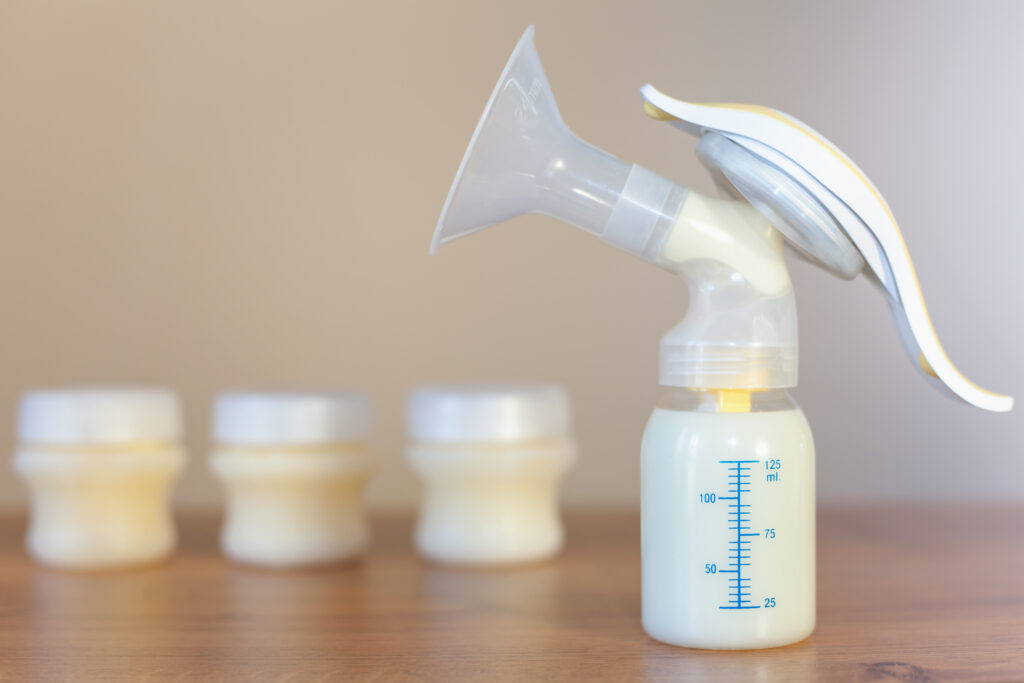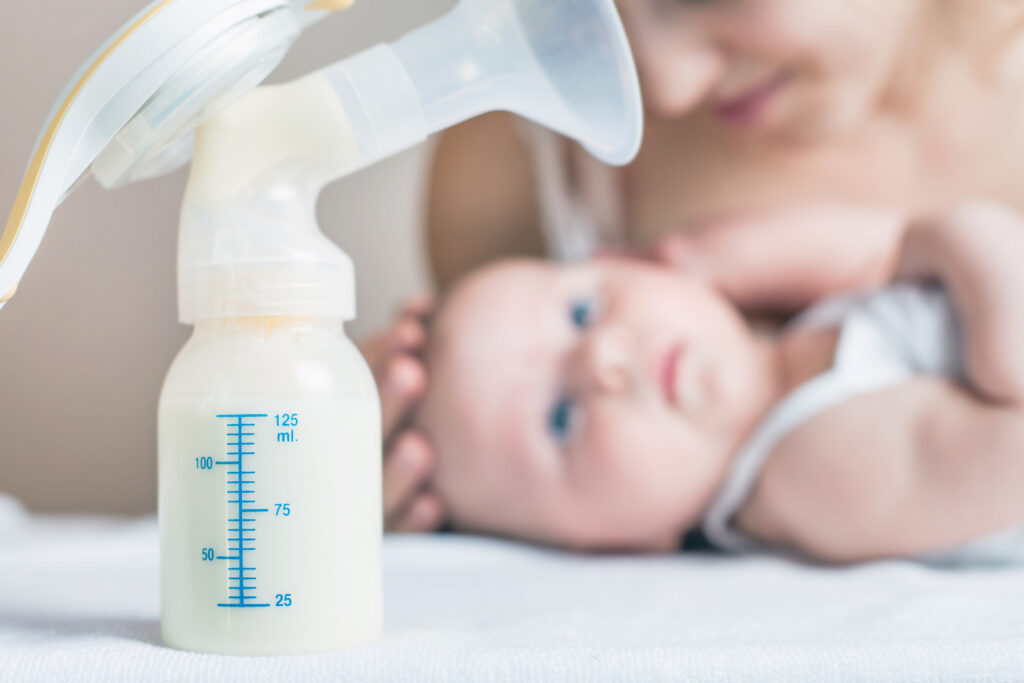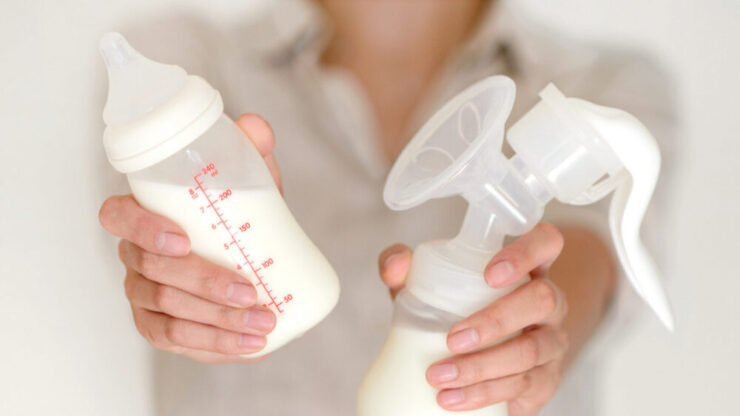Exclusive pumping often referred to as Eping can be really stressful for you as a new pumper but as you step ahead in your motherhood journey, it becomes a daily routine.
Table of Contents
What is exclusive pumping (Eping)?
Eping is a perfect alternative solution for breastfeeding. It’s a method used by mothers who have difficulty breastfeeding due to several reasons I’ll highlight in this post.
Exclusive pumping promises that the child will get nothing less than the full nutrients breastfeeding will give.
Although, health care organizations such as the World Health Organization (WHO) and Healthy children recommend breastfeeding only for the first year of a child’s development.
Understanding how breastfeeding works
Breast milk is produced in the areolar tissue portion of your breast. While you are pregnant the flow of progesterone hormone causes your breast not to release the milk produced. Hence you discover that close to delivery period, your breast seems full. As your baby grows, your breast produces milk that satisfies his nutritional needs.
Why do you need to pump exclusively?
Everyone who does exclusive pumping has a reason of preference over breastfeeding.
Here are some of the reasons:
- Medical issues involving medications
- Busy work schedule
- Flattened nipple and areolar
- Insufficient supply of milk
- Underdeveloped or ill baby
- Painful breastfeeding
Accessories needed to get started with exclusive pumping
There are several accessories needed to ensure a successful pumping routine. But of course the most important is the breast pump because all pumping activities rely on the pump
Breast pump: This is the device lactating women use to extract milk without breastfeeding the baby.
You can either choose a manual pump for occasional pumping or an electric pump for pumping exclusively
Storage bags
The major reason for pumping exclusively is to keep the milk for a long time. Storage bottles won’t hold much milk at once and can’t store safely for a long time.
Therefore you need an affordable storage bag for milk. You can purchase them in bulk as they’re very affordable and take smaller space in the freezer for long term protection
Cooler or Freezer
Your milk will not survive too long under room temperature. Therefore you need to keep it cool always.
A storage bottle can keep milk good up to 6 hours at room temperature but a good storage cooler or freezer can extend the lifespan of pumped milk up to 6 months. Take a look on my post on best cooler for frozen breast milk
Bottles
You can’t directly feed your baby from storage bags. So having some milk bottles around is very essential
I advise you to get as many as possible with different nipple sizes and shapes because your child’s response to thesebottles may differ.
I had so much success with the medela bottles, my children so much loved it although I alter with different nipple sizes. Once they adapt with one, I stick to it.
Extra pump parts
It is very important to have about 2 extra pairs of pump parts that you can use while you wash the pump follow-come parts.
Letting each pair dry when you wash them while you keep using the spare ones you bought is the aim.
A hands-free bra
I have really enjoyed using the D*lite hands-free bra because it allows me to adjust the size using the velcro panel.
With a hands-free bra you don’t have to hold your breast bulge while pumping you can as well be doing something else while in your pumping session.
Nursing cover
You don’t want to stay home all through pumping sessions, it’s going to be an all boring experience.
Nursing covers had got you covered. Lol!!! By allowing you to pump in public. You may get nursing covers for summer or ordinary pumping covers as the case may be.
Precautions for successful pumping
In order to make most out of pumping and also not affect your child’s developmental process adversely, it is important to take care of your body as well as your pumping accessories.
Taking care of your body

While you plan on making an exclusive pumping schedule it is also very vital to take care of your body as it determines the purity of the milk that flows from you.
Don’t take much caffeine as it can hypnotize your child. Eat more of green vegitables and vitamin supplements that will enhance your milk production.
Don’t take drugs that affect the secretion of oxytocin and prolactin as it will inturn lower your production rate.
Taking care of pumping tools
Cleaning up your pumping tools every now and then reduces the level of exposure to germs.
Leaving a used bottle for too long could be an initial habitat for molds and bacteria which could cause infections for your baby.
Exclusive pumping schedule

You want to achieve your pumping target without feeling stuck to your pumping device all through the day.
The target is 20-35 ounces per day. When you’re a new pumper, this may take up to 10 sessions of 20 minutes per session from you but as your baby grow older and your milk established, the pump time lessens.
It can take your sleep time because you’ll have to wake up in the night for sessioms too but maybe after your baby is about 6 months, you can have a good sleep time also.
The older the baby become, the less time you need pumping.
Pump milk while caring for your baby
It is very important to learn this. I think in an ideal world your partner should help take care of the baby while you pump. But I learned when pumping for my little John and Casmis (My hobby) would sit and watch TV while John cries and I pump.
I discovered bringing him closer by carrying him causes him to start fondling with the pump parts thereby engaging him. Then after a while, I easily put him to bed
Learning how to balance pumping with taking care of your baby is a must.
How to increase supply when you’re exclusively pumping
Not enough breast milk? Probably because your baby eats more than you produce.
I know it’s a really stressful experience because I’ve been there. While your physician will recommend adequate rest and more sleep time, it doesn’t work that way in exclusive pumping.
It is essential you meet your baby’s voluminous and nutritional needs. I have shortlisted some of the things that helped me produce more milk when it was needed.
- Lactation supplements
- Increase pumping time and frequency
- Drink enough water
- Take beer
- Do more of Oat meal
- Cluster feeding
These are the tips that really helped me overcome insufficient milk. You can as well try them out if you’re facing this challenge.
Storing breast milk from exclusive pumping
After pumping your breast milk you either
- Feed your baby
- Store it in the fridge
- Or freeze it
Feeding your baby with the pumped fresh milk might not require much storage. Storage in a bottle is enough as it can last up to 6 hours at room temperature.
Refrigerated breast milk will last up to 8 days. So if you intend feeding your baby with your pumping sessions from yesterday, a refrigerated milk is not a bad option.
Moreover, if you have a couple of bottles in the fridge, it’s better you label them with date so you won’t feed your child with expired milk.
Although you’ll have to use a bottle warmer to get the milk a bit warm, please do not microwave breast milk as it could burn the baby’s mouth
Frozen breast milk will stay hygienic for up to 180 days. Yes you saw right, whooping 6 months. You can either use a glass, bottle or storage bags to freeze breast milk. You will also need to bottle-warm frozen breast milk
4 tips to make pumping easier

Pumping exclusively can be more tasking than breastfeeding in so many ways. Although it has many edges over breastfeeding on the mother’s side.
Aside from the pumping itself, washing and cleaning pump parts, arranging and preparing bottles could be tasking.
I will show you 4 tips to make your pumping routine hassle-free.
- Hands-free bra is very important in making your life easier as an active pumper because it allows you multitask while pumping. Investing in a hands-free pumping bra is really rewarding.
- Pump into the bottles that your baby drink from to save a lot of time transferring from one bottle to another. You can attach a pair of bottles that your baby likes to drink from to the pump.
- Pump on the Go, it is very vital that you love and learn to pump on the go. For instance while driving, flying or in public. All these are achievable as long as you don’t get distracted by the pumping activity.
- Set up a pump station in your house. As a person, I use a single couch in my room. I have there all my necessary pump tools and also some side attractions like my Chromebook, TV remote, etc.
How to decrease your milk supply if it flows too much
When there is an oversupply, some mothers have issues with clustered ducts and mastitis. For some mothers, it is weaning time already and their breast keeps producing much milk.
If you find yourself in this kind of situation and thinking about what to do, I have a few tips listed here that will help you reduce your milk flow supply.
They include:
- Eating sage
- Taking sudafed
- Cabbage leaves do the magic
- Gradually drop your pumping schedule
Exclusive pumping VS Breastfeeding
Who and other health organizations recommend breastfeeding as the primary and effective way to feed a baby for proper development. But most mothers still prefer exclusively pumping for their children. I’m proud to announce to you that I’m one of them.
In this section, I’ll list the Pros and Cons of each.
Pros of breastfeeding
- Ideal food baby
- Builds a stronger immune system
- Convenient and affordable
- Strengthens mother-child bond
Pros of Eping
- Optimal control
- Addressin
FAQs
What volume should I produce?
Daily target should be between 25 and 35 ounces. It means in 24hours your goal is to have pumped say 30 ounces of milk. It could take about 8 hours of active sessions. But as your baby grows older, less pumping activity is required because he won’t eat every minute again.
Frequency of pumping session
Often you have to refill as soon as your baby eats. So the quantity consumed is always equal to the quantity supplied. Therefore about 20 minutes session, 8-10 times in a day would do when you’re just starting out as a new pumper.
Are used pump cool?
The simple answer is NO. You don’t have to use used pumps when you can pirchase new ones at little prices. Used pumps may expose your baby to the risk of molds and bacteria.
Final thoughts
You have made a right decision by choosing to pump exclusively for your child. But you have to get all the tools needed, take all precautions and plan a right pumping schedule. If you have any questions or comments please make use of the comment section. I’ll do well to answer them as soon as possible.
Important reads:

